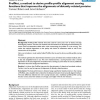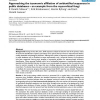BMCBI
2005
13 years 11 months ago
2005
Background: The inference of homology from statistically significant sequence similarity is a central issue in sequence alignments. So far the statistical distribution function un...
BMCBI
2005
13 years 11 months ago
2005
Background: General protein evolution models help determine the baseline expectations for the evolution of sequences, and they have been extensively useful in sequence analysis an...
BMCBI
2005
13 years 11 months ago
2005
Background: The ability to distinguish between genes and proteins is essential for understanding biological text. Support Vector Machines (SVMs) have been proven to be very effici...
BMCBI
2005
13 years 11 months ago
2005
Abstract. Taxonomy provides one of the most powerful ways to navigate sequence data bases but currently, users are forced to formulate queries according to a single taxonomic class...
BMCBI
2005
13 years 11 months ago
2005
BMCBI
2005
13 years 11 months ago
2005
Background: Profile-profile methods have been used for some years now to detect and align homologous proteins. The best such methods use information from the background distributi...
BMCBI
2005
13 years 11 months ago
2005
Background: Although DNA microarray technologies are very powerful for the simultaneous quantitative characterization of thousands of genes, the quality of the obtained experiment...
BMCBI
2005
13 years 11 months ago
2005
Background: Post-translational modification by Small Ubiquitin-like Modifiers (SUMO) has been implicated in protein targeting, in the maintenance of genomic integrity and in trans...
BMCBI
2005
13 years 11 months ago
2005
Background: Several problems exist with current methods used to align DNA sequences for comparative sequence analysis. Most dynamic programming algorithms assume that conserved se...
BMCBI
2005
13 years 11 months ago
2005
Background: During the last few years, DNA sequence analysis has become one of the primary means of taxonomic identification of species, particularly so for species that are minut...





